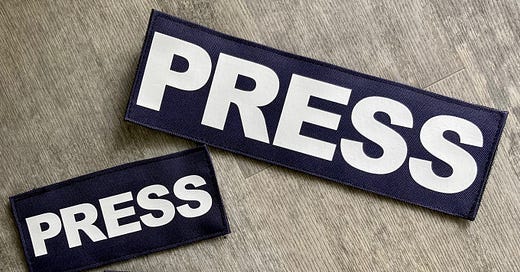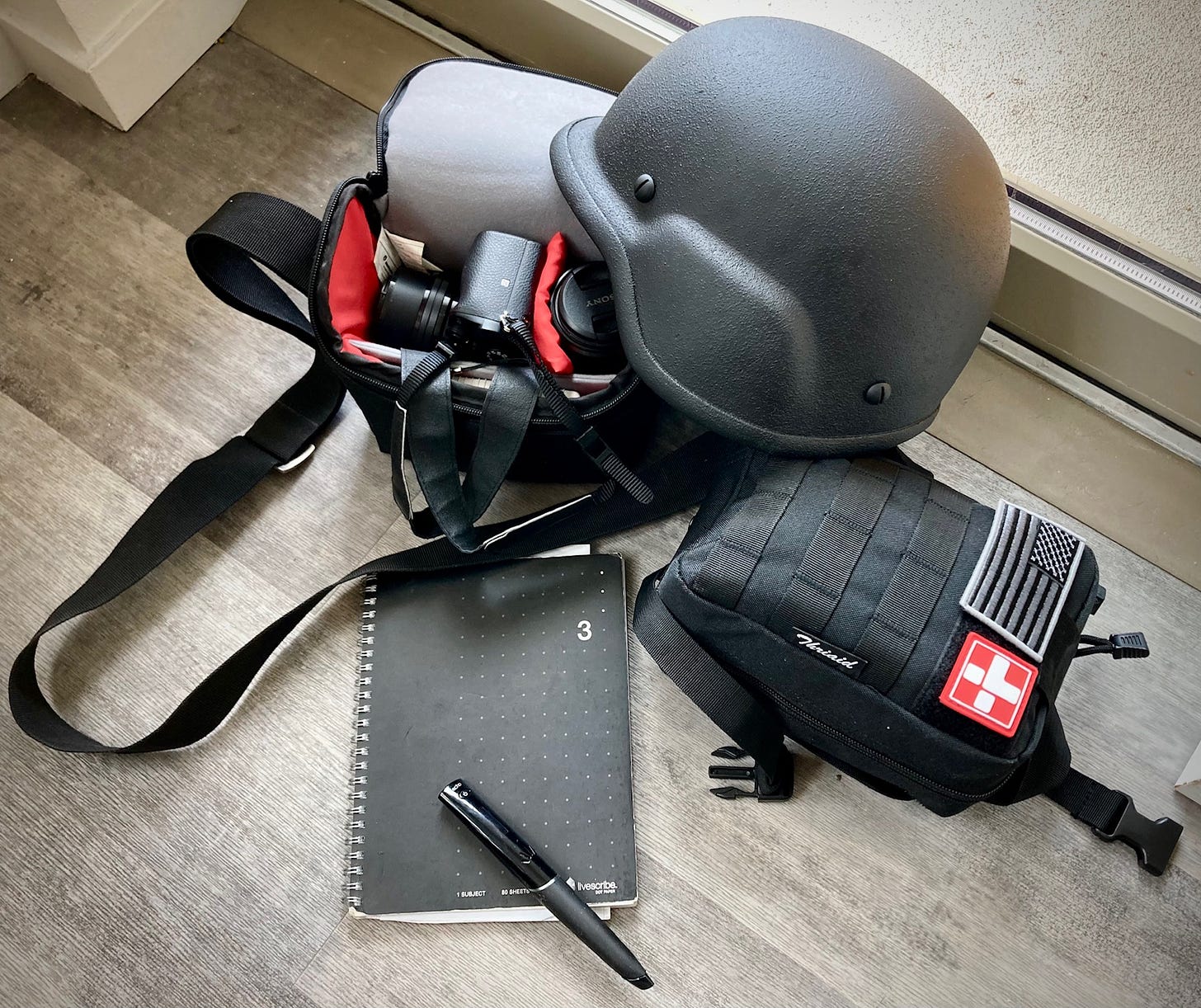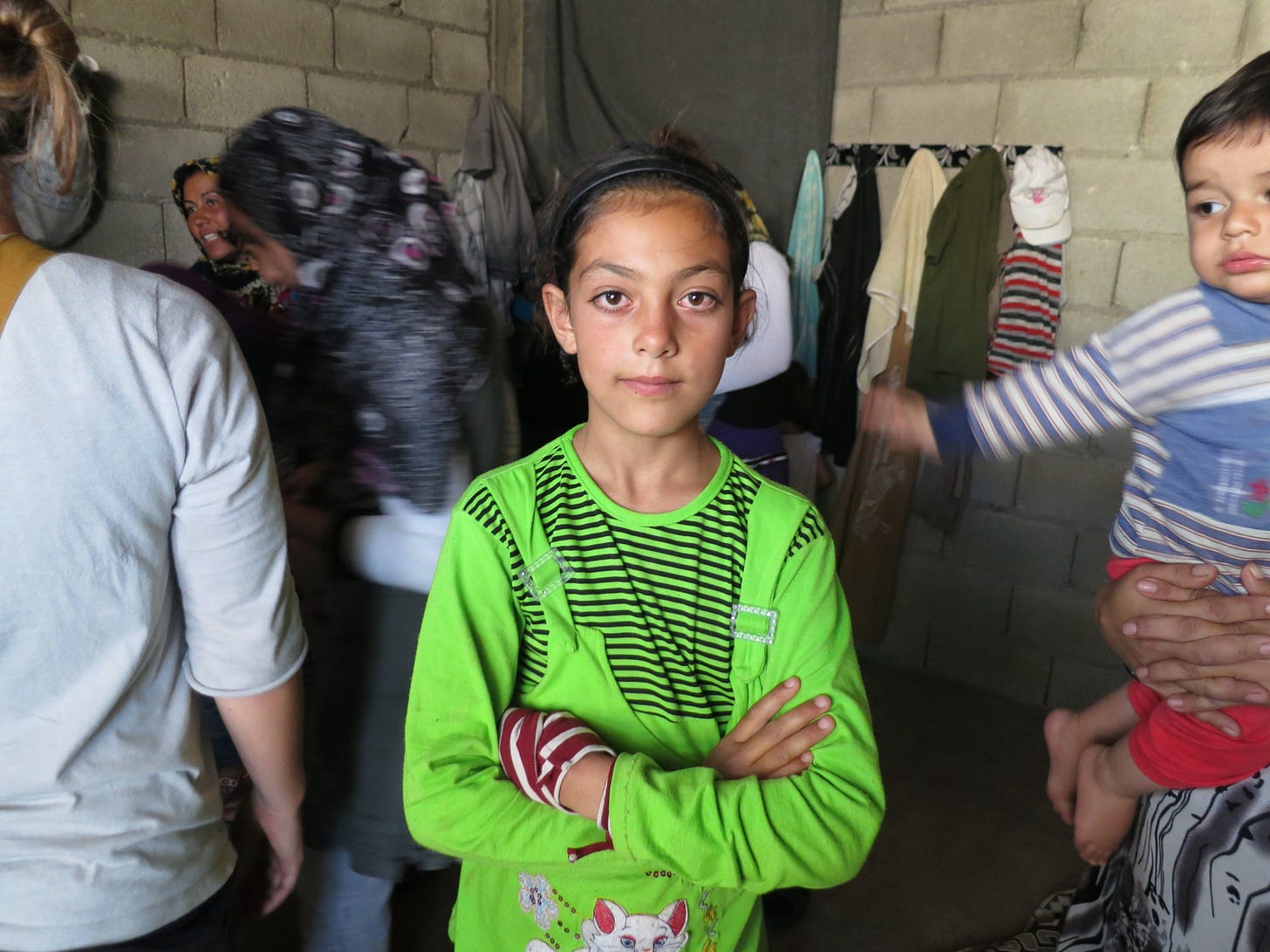Journalism is too opaque and misunderstood. Chills gives a behind-the-scenes look at how dangerous investigative journalism gets made.
I’m making a list. And I’m checking it 1,000 times. Because I’m going to Ukraine for a story, and forgetting anything seems like a bad idea.
I’ll be writing a long-form piece for a major newspaper about war crimes, reporting on a particular investigative effort. Details TK (aka “to come” in journalism parlance. It’s “TK” and not “TC” because in old-school print, the “K” stood out more. It’s commonly used in drafts to tell your editor that you know you’re missing something, but the information is coming).
Here are some of the essentials I’m taking — and not, although I wish I could — and the stuff I need to do before I go, or when I get there.
First, the mainly techie stuff:
Body armor: I’ve purchased a Level IIIA+ vest, Level IV rifle plates and a Level IIIA ballistic helmet in navy blue, the color that identifies you as a journalist. Also, Velcro “press” tags — although in some arenas, you don’t want to actually wear them: journalists are now prized targets in many conflicts.
About these from one manufacturer, Safe Life Defense: the vest is “spike-rated NIJ level 1 for protection up to 36 joules of stab force. In conjunction with our level IV rifle plate, our armor protects against rifle threats up to .30-06. These vests not only stop bullets, but they're also strike, slash, stab, taser and special threat resistant.”
This is the standard recommended level of protection right now for people traveling to Ukraine, and it costs nearly $2,000 new.
The sellers I spoke to are on back-order for plates and some vests because of the war in Ukraine, and, horrifyingly, school shootings.
Emergency field first aid kit: Includes a tourniquet and items for trauma care.
Plastic tag: To hang around my neck, marked with my blood type.
(The above items come recommended by my wonderful and brilliant journalist friend Frank Smyth, who is an expert in press freedom and the NRA. He founded and runs Global Journalist Security, the U.S. leader in hostile environment training, known as HEFAT. Frank’s work is incredibly interesting — read his bio here.)
Audio recorder: I upgraded my equipment to a Zoom H4n Pro, recommended to me by people at a podcast company I admire.
One of the first lessons I learned in j-school was to always multi-platform my work. (Granted, that was back when they were trying to figure out how to teach “online journalism”…) So maybe I’ll do a podcast or a documentary after the story. Who knows? Better to gather the reporting in all possible ways while there.
I’ve published, along with my stories, many photos I’ve taken in the field. Today’s lack of budgets at news outlets mean that, as a freelancer, you don’t usually get to have a photojournalist with you. You have to be your own.
Camera/phone: All set with my Sony mirrorless camera and lenses and batteries and charger and SD cards. I’ll also be taking video with my camera as well as my iPhone, for which I either need to switch out the SIM card once I’m in Ukraine so I don’t get charged a million dollars for calls, or pre-arrange with my phone company to have somewhat affordable international rates.
Livescribe pen/notebooks: The pen was recommended to me years ago by friends at human rights organizations. I can’t even describe how magical it is, but it’s saved me over and over as someone who can’t write down quotes fast enough.
To do:
Hire a fixer/driver/translator: Fixers are people who are local, so best know the terrain. They help you set up interviews and logistics. Sometimes they drive you, sometimes they hire the driver for you. Often, they’ll also do translation. We find fixers through word-of-mouth, for the most part.
A good fixer is worth everything — he or she can make or break your reporting trip, or even save your life with their knowledge and quick thinking.
When I was at the border of Syria in Turkey a number of years ago, my fixer physically had to pull me out of the middle of a virulent argument between men about why I was there. We were in a public park where about 4,000 Syrians were squatting. The UN Refugee Agency wasn’t present, nor were any NGOs. There was no running water and scabies were rampant. It was also more than 90 degrees with a relentless sun. People were exhausted and desperate.
I wanted to speak to the women in the park, but the men blocked my way and started yelling and gesturing at each other wildly. A crowd gathered, closing in. One man wanted to know what the hell I was doing there if I wasn’t there to give them answers, or food, or health care, or money or assistance of any kind, and another man told him to leave me alone and let me do my work. As the fight escalated, I felt a hand on the back of my shirt pulling me out of the melee, probably saving me from harm, and certainly saving me from a nightmare situation.
It’s times like these where being a reporter feels completely inadequate. I always explain to the people I interview that by telling stories about what they are enduring as refugees or survivors of violence, my hope is that policymakers, NGOs, etc. will pay attention and act. Some people understand this, others, understandably, don’t. Who cares about an article when you’re hungry?
I’ve put out feelers to various recommended fixers, and just now believe I’ve found an excellent person in Kyiv.
Book a hotel/flights/trains: Self-explanatory. Except for the fact that I’m kicking myself because moving from NYC to Seattle has added a good seven hours to my trip, making it a minimum 20+ hours of travel each way. (But not really; I’m glad I moved.) Also, I have to fly into Poland, then take a 10-hour train to Kyiv.
A wish and some essentials:
A shower and a bed: This would be for all the people I meet who have suffered in this war and just need a damn break.
After that trip to the border of Syria, I flew back to Istanbul, where I was staying at a very mirrored and marbled hotel. I cried my face off when I hit the disconnect, which always happens after my reporting trips — how is it that I get to shower and sleep in this gorgeous bed when all the girls and women I’d just met are living without running water and sleeping on floors in broken concrete structures or makeshift tents?
Toiletries: Only the essentials, space is tight.
Food: I generally take Luna bars or nuts on a trip like this, in case I don’t have time to find food, or can’t find anything without meat. But again, space is tight.
Cargo pants: Because having everything in your backpack and hanging off your neck is a lot.
Boots: They have to be comfortable and ready to tromp through mud and wreckage. Maybe a pair of sneakers too.
Water bottle: Self-explanatory. You never know how many hours you’ll be in the field. Water is a must.
Backpack: I live and die by my backpack, which is an olive-green Hershel I’ve had for about 10 years. It’s been everywhere in the world with me and it’s like my child. I’d love to buy a new one, but the rest of the things on this list are breaking the bank.
Scarf: My red-and-white scarf was with me on 9/11, fortunately, because I was breathing in the towers and the people in them. I kept that scarf tied to my messenger bag for years. You never know when you’ll need to cover your mouth. (Then again, 2022: masks.)
Covid tests: One before flying and one before re-entering the U.S.
Kindle: Because I read nearly every night. Even on trips like this. You need a timeout from all the awful crap you’re reporting on.
This is only a partial list because I know I’m forgetting to include a bunch of things. I keep a running list on my phone that I add to whenever I think of something else to do or buy or bring. Hopefully, this gives you some idea of the intense preparation that goes into a reporting trip to a war zone.
Also, maybe this explains how expensive this kind of reporting is.
I just sent my editor an estimated budget of a record-smashing (for me) nearly $10,000. That doesn’t include the body armor, etc. — items I bought that will be mine after this. In my 20 years of (mostly) freelancing, no outlet has ever paid my expenses, minus the Women’s Media Center for a trip to Congo. Surviving purely as a freelancer is a young person’s game.
I have no idea how much reimbursement the paper I’m on assignment for this time will throw my way, but I’m committed to this story. My editor, who I’ve written for before, asked me to put together a budget. That’s the first time any editor has ever asked me to do this.
Not everyone has the financial padding to pay for everything that will keep you safe and sane in a war zone. I spent most of my career working full-time in journalism-adjacent jobs, which allowed me to travel to report stories I felt were important. Still, for the most part, my 1,500/2,000-word stories from dangerous assignments only netted me $250-$350 each. I wish I were kidding.
Even 10 years after reporting my first story for a major magazine — and 20 years of experience in journalism — I recently was paid in that range by the same outlet.
As I said, I’m committed to this story. And I’m very grateful that the newspaper took my pitch. I worry though that the last 20 years of a dying media (since the advent of the internet) means that stories like the one I’m about to report are impossible to do for most. There are so many talented journalists out there, and so many critical stories to tell. If only there were a public value placed on our work, instead of being branded “enemies of the people” and dismissed as yellow journalists by people who have never read our hard-won efforts.
This is not a plea for sympathy. This is simply a picture of the reality we’ve created for the Fourth Estate in this country. I hold hope for the future that the situation may improve. But I don’t think I really believe that. Instead, it looks like our democracy will increasingly lose our gadflies to buyouts, layoffs and low wages. And those of us doing this kind of journalism will only face an uphill battle to make it happen.
On Chills, there are no ads, and no outside influences because of it. This is a subscriber-supported space that gives a behind-the-scenes look at how risky investigative journalism gets made, from a journalist with 20 years of experience. Read Chills for free, or subscribe for bonus content like this. You can sign up here. Thank you for supporting independent journalism.








I don’t have many paid subscriptions, simply because of budget, but not only your writing but your commitment and perceptiveness make Chills one of them. Now add an additional layer of doggedness. Of course, with everyone else, I wish you safety and success at getting the story.
Grateful to you for your skills and your calling 🙏🏼